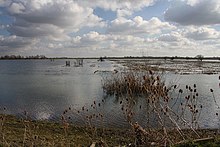Washland
Appearance



Washland or washes are areas of land adjacent to rivers which are deliberately flooded at times when the rivers are high, to avoid flooding in residential or important agricultural areas.[1][2][3] They often provide for overwintering wildfowl, and several include important nature reserves.[4][5]
Examples of washlands include:
- The Ouse Washes of Cambridgeshire and Norfolk
- The Nene Washes of Cambridgeshire
References
[edit]- ^ "Collaborative Landforms Gallery". The Geograph Project. Retrieved 20 June 2014.
- ^ Wheeler, William Henry (1896). A History of the Fens of South Lincolnshire. 2nd Edition (facsimile edition, 1990 ed.). Stamford: Paul Watkins. ISBN 1-871615-19-4.
- ^ "The River Ouse project". The River Ouse project. University of Sussex.
Such areas are known as 'washlands'
- ^ "About Ouse Washes". RSPB. Retrieved 20 June 2014.
- ^ "Trent Valley Washlands". National Character Areas. Natural England. Retrieved 20 June 2014.
